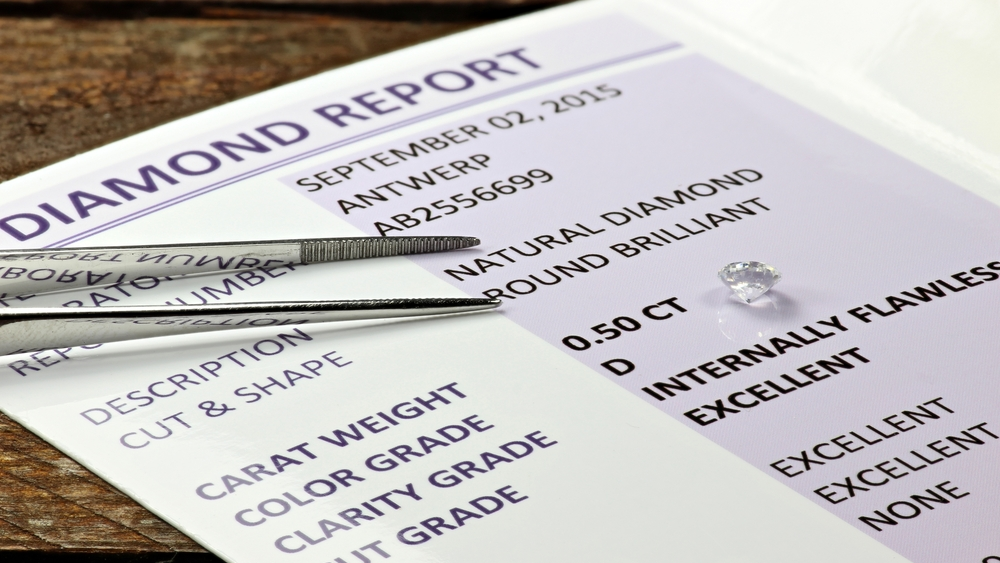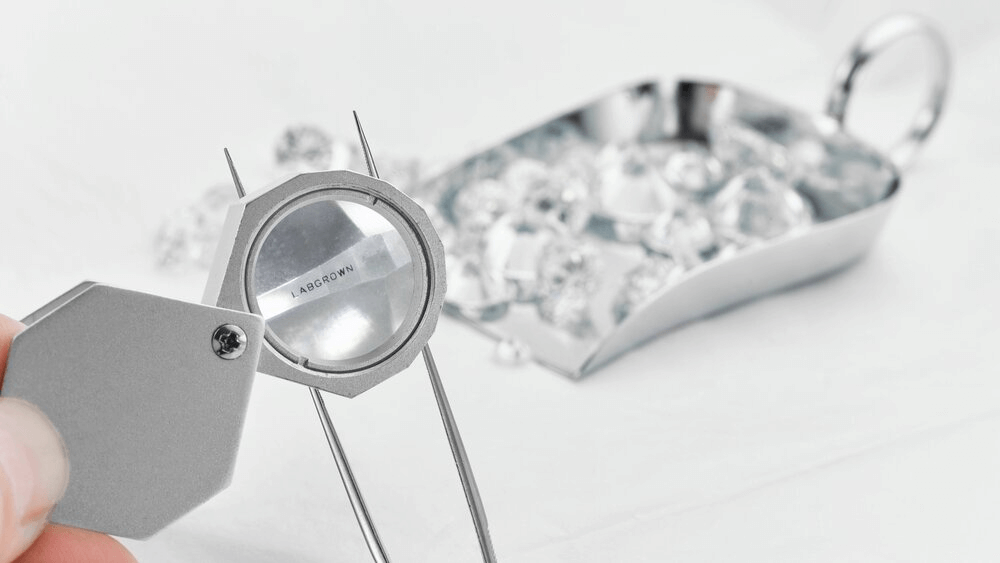Exposed: The Reality Behind GSI Diamond Grading!

By Gary A.

Edited by Olivia H.
Published Jun 2, 2021
Edited on Dec 18, 2024
When it comes to finding a balance between quality and price, GSI diamond certification offers an option that might be worth considering—especially if you know what to look for.

- 5 Quick Tips for Buying a Diamond Engagement Ring with GSI Certification
- Introduction
- The History and Influence of GSI
- Decoding the GSI Grading Scale
- The GSI Quality Report: What It Entails
- GIA vs GSI: A Comparative Study
- Advantages and Disadvantages of GSI Certification
- 8 FAQs
Before we dive deeper into the specifics, here are some practical tips to help guide your decision-making process:
5 Quick Tips for Buying a Diamond Engagement Ring with GSI Certification
Navigating the intricacies of diamond certifications, especially from organizations like GSI (Gemological Science International), can be challenging. Here are practical tips to ensure you make an informed decision when purchasing a diamond engagement ring.
- Tip 1: Understand the GSI Grading Scale: Familiarize yourself with the GSI grading scale. Unlike GIA, which has established a reputation for stringent grading, GSI’s criteria can be more lenient. Be aware that a GSI certification might not hold the same weight as GIA in terms of strictness and consistency. Compare GSI grades with other labs. If you come across a diamond with a GSI certificate, it’s helpful to compare its grades with GIA or AGS equivalents. This will give you a better sense of the diamond’s actual quality.
- Tip 2: Pay Close Attention to the 4 Cs: Scrutinize the 4 Cs carefully. With GSI-certified diamonds, it’s crucial to closely examine the carat, color, clarity, and cut. Given GSI’s more lenient grading, a diamond’s actual color or clarity might be a grade lower than what is stated on the certificate. Focus on the cut quality. The cut of a diamond significantly affects its brilliance and fire. A well-cut diamond, even with a slightly lower color or clarity grade, can still look stunning.
- Tip 3: Research GSI Serial Numbers and Online Verification: Verify the diamond’s certification online. GSI provides an online platform for verification using the diamond’s report number. Ensure the diamond’s certification matches the details of the actual stone. Look up the diamond’s serial number. A genuine GSI report will include a unique serial number inscribed on the diamond, usually visible under magnification. Verify this number for authenticity.
- Tip 4: Be Aware of Market Pricing and Value: Educate yourself on market pricing. Understand that a diamond’s price should reflect its quality. GSI-certified diamonds might be priced lower than GIA-certified ones, but this could also indicate lower quality. Consider the resale value. Diamonds with GSI certification may not hold their value as well as those with GIA or AGS certifications, which is important to consider if you plan to upgrade or sell the ring in the future.
- Tip 5: Analyze Inclusions and Blemishes with Care: Examine inclusions and blemishes. GSI reports include detailed diagrams showing the location and type of inclusions. Use this to assess how these imperfections might impact the diamond’s appearance and durability.
Now that you’ve got these practical tips, use Jeweler AI below to find the perfect engagement ring that suits your style and budget:
Introduction
There’s no objectively ‘right’ way to grade a diamond. Yes, most of the diamond world has long since embraced the GIA’s pivotal Four Cs – including us – but, even so, there are plenty of other bodies and organizations offering their own methods for certifying diamonds.
Understanding the GSI’s Unique Approach
The GSI (or the Gemological Science International) is the newest gemological organization, having only been established in the 21st century. As a result, it’s not as widely recognized as some of the more established institutes, such as the Gemological Institute of America, although, even as a first-time shopper, you’ll likely see the name crop up from time to time.
A GSI diamond certification is offered in a variety of grading reports, depending on the client’s needs. The grading report evaluates the diamond on its quality and structure, and its own list of advantages and disadvantages to buyers.
The History and Influence of GSI
The Gemological Science International, GSI, has only been in existence for a few years, being founded in 2005. GSI was established in New York City, with locations worldwide. They are a for-profit organization, with the majority of their business appealing to large retail chains in the United States – primarily as a result of their rapid turn-around and cost-effectiveness for these vendors.
A GSI diamond certification is considered “looser” in their grading reports, much like EGL, which leads to inconsistent results and, in effect, less reliable prices.
Decoding the GSI Grading Scale
Much like many of the most prominent grading methods, the GSI’s diamond grading approach is categorized by 4 C’s: carat, color, clarity, and cut:
Cut, Clarity, Color, Carat: GSI’s Interpretation
GSI includes the diamond’s carat size in its grading report. It’s important to note that a diamond’s carat is based on its weight, not its size, with one carat equaling 0.2 grams.
GSI grades the color of a diamond on the same grading scale as GIA’s grading scale – a letter color scale from D – Z. The less color a diamond has, the higher its value will be. A diamond graded with the letter D represents a colorless diamond and continues up the scale to a diamond with the letter Z representing a light yellow or brownish tint.
GSI grades clarity on how clean a diamond is from inclusions and blemishes. The diamond’s clarity is based on the 0-10 scale, with a score of 0 being completely flawless up to a score of 10 which includes flaws.
Much like the GIA, CSI grades the cut of the diamond on the following scale, based on its proportion, angles and symmetry:
- Ideal
- Excellent
- Very Good
- Good
- Fair
- Poor
The GSI Quality Report: What It Entails
While the GSI diamond certification/grading report follows a similar structure to the GIA’s own reports, in that it provides a complete assessment of the stone’s 4 C’s, it also includes information about the cut by analyzing information about proportions, polish and symmetry.
Grading reports are printed with varying formats, details and prices and include educational material to help consumers understand the information. The report also features various diagrams, illustrating the exact position, size and shape of each inclusion and blemish along with clarity characteristics and proportions.
Along with the diamond certification, GSI also provides:
- IDX and MDX: smaller versions of a full certificate
- Trade Consultation Report
- Hearts and Arrows Report
- Light Performance PSX Report
- Metal Engraving
- Laser Inscription
- Virtual Vault: a consumer security service
GSI Certification Sample
GIA vs GSI: A Comparative Study
The main reason why a diamond report is seen as an essential document for any diamond buyer (whether first-time or old-hat) to look for is because it offers a neutral appraisal of the diamond’s value.
The trouble with the GSI is the fact that it has made its name offering a fast turnaround for some of the largest jewelry chain stores in the country. There is a reason why they favor this system: not only is it cost-effective and fast, but it’s also known for being pretty loose.
What does this mean? It means that a diamond graded by the GIA is likely to be subjected to much stricter standards than it would be by the GSI and that unwary shoppers could end up paying more for a lower quality diamond as a result.
The GIA is a non-profit organization, offering a much more cautious and consistent approach to grading diamonds. As a result, the information found within one of their reports will be composed in a way that does not favor the seller, but which imparts a more neutral appraisal of the diamond’s strengths and weaknesses as an investment.
So, in spite of the fact that there is considerable crossover between the grades used by the GIA and the GSI, there is a world of difference between the two organizations’ approaches to diamond quality – and how they report on that quality.
How GSI Certification Favors Vendors
GSI certification is quick and cheap, which means big-name jewelry chains can get a huge number of diamonds certified with a smaller investment of time and money. This has a direct impact on the customer. With a report, the diamonds can fetch a higher price – but GSI’s inconsistent grading approach means that higher price is unlikely to be a true reflection of the value of the diamond.
Advantages and Disadvantages of GSI Certification
Advantages
A GSI diamond report offers a grading discount to diamond vendors, as well as providing fast grading services. This can make it a lot easier for sellers to get larger numbers of diamonds checked and certified, at a much lower cost.
For buyers, these reports can also offer a little more in terms of education, ensuring that less experienced shoppers and investors can understand the report, and why each section matters.
Disadvantages
Unlike some of the more established gemological organizations (and their widely-used methodologies for grading) the GSI’s reports can lead to inconsistent, loose, and weak grading. The time- and cost-effectiveness of a GSI report generally falls in favor of the vendor, rather than the buyer, and is outweighed by the lack of reliability.
Buyers would be better advised to opt for a GIA graded diamond instead, and to avoid paying over the odds for a diamond that has been graded in favor of the company selling it, rather than the individual buying it.
8 FAQs
- Q: What is GSI Diamond Certification?
- A: GSI (Gemological Science International) Diamond Certification is a report that evaluates the quality and characteristics of a diamond based on the 4 Cs – Carat, Color, Clarity, and Cut. GSI is a newer gemological lab and its grading standards can be more lenient compared to older, more established labs like GIA.
- Q: How Reliable is GSI Certification Compared to GIA?
- A: GSI is generally considered less stringent and consistent compared to GIA. GIA (Gemological Institute of America) is renowned for its rigorous and consistent grading system, making it more reliable and widely accepted in the diamond industry.
- Q: Can I Trust the 4 Cs on a GSI Certificate?
- A: While a GSI certificate provides a basic assessment of the 4 Cs, it’s advisable to approach it with caution. GSI’s grading can be more lenient, so a diamond’s color or clarity grade might be slightly overstated compared to GIA standards.
- Q: Is a GSI Certified Diamond Cheaper?
- A: Yes, diamonds with GSI certification can be cheaper than those with GIA certification. However, this may be due to a lower quality in terms of color, clarity, or cut.
- Q: Can I Verify a GSI Certificate Online?
- A: Yes, you can verify a GSI certificate online using the report number provided on the certification. GSI offers an online verification service for this purpose.
- Q: Are GSI Graded Diamonds Good for Engagement Rings?
- A: GSI graded diamonds can be suitable for engagement rings, but it’s important to carefully assess the diamond beyond just the certificate. Consider getting a professional second opinion for a more accurate assessment of the diamond’s quality.
- Q: How Does GSI Certification Affect Resale Value?
- A: Diamonds with GSI certification may have a lower resale value compared to those with GIA or AGS certifications. This is due to the perception and recognition of the grading lab in the global diamond market.
- Q: Can I Upgrade a GSI Certified Diamond?
- Answer: Upgrading a GSI certified diamond is possible, but you may find that its trade-in value is lower compared to a diamond with GIA certification. It’s important to consider this when making an initial purchase with future upgrades in mind.
Unlock the secrets of GSI diamond certification with Jeweler AI and choose the perfect ring with confidence.
FOLLOW-UP GUIDE SERIES







